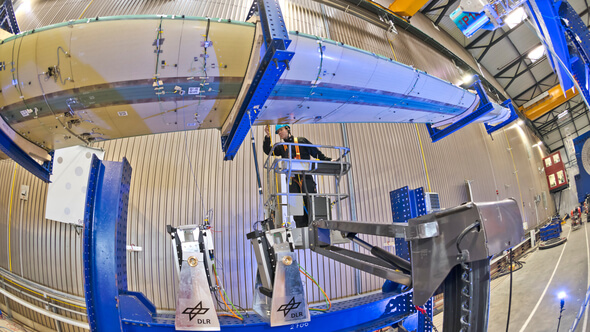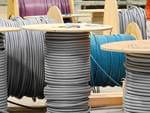News Release from Deutsches Zentrum für Luft- und Raumfahrt e.V.
Wind Industry Profile of
Wind power – innovative vibration tests on rotor blades
An electrodynamic vibration exciter pulls and pushes at the 20-metre SmartBlades DemoBlade with a force of 100 kilograms. The rotor blade oscillates with a deflection of 50 centimetres at the tip. Researchers from the German Aerospace Center (Deutsches Zentrum für Luft- und Raumfahrt; DLR) are conducting precise analyses of these movements and the material stresses on the rotor blade. To do this, the researchers have fitted 300 acceleration and 200 strain sensors directly to the blade. The data they record enables logging of the deformation in the rotor blade with millimetre precision; this is then compared with a simulation model. With these innovative vibration tests, the researchers obtain data on the vibration patterns of rotor blades with hitherto unparalleled precision and quality. The tests were carried out at the Fraunhofer Institute for Wind Energy Systems (IWES) in Bremerhaven as part of the SmartBlades2 research project. In this project, research institutions are collaborating with industrial partners to develop technologies for larger and higher-performance wind turbines. The project is funded by the German Federal Ministry for Economic Affairs and Energy (Bundesministerium für Wirtschaft und Energie; BMWi).
Test methodology developed for aircraft prototypes
This test methodology was originally developed for vibration testing by the DLR Institute of Aeroelasticity in Göttingen. It is used to conduct static vibration tests on aircraft prototypes. Yves Govers from the DLR Institute of Aeroelasticity transferred his experience to wind turbines to analyse the demonstration blade in Bremerhaven: "We are familiar with the design of the newly-developed rotor blade and calculated its behaviour in advance. The sensors give us the opportunity to measure the actual structural dynamics of the blade, meaning we can adapt our computer models to reality and design better rotor blades."
A rotor blade developed in the SmartBlades project was set up on the test rig in Bremerhaven. Researchers from the DLR Institute of Composite Structures and Adaptive Systems built the 20-metre blade in the Center for Lightweight-Production-Technology (Zentrum für Leichtbau-Produktionstechnologie; ZLP) at the DLR site in Stade. Geometric bending-torsion coupling is a new feature of this blade. To achieve this, it is given a crescent-shaped geometry; when exposed to wind, the blade not only bends backwards, but also rotates slightly around its axis, allowing the blade to adapt its geometry independently to accommodate the prevailing wind conditions. It does this by turning away from stronger winds and presenting a smaller surface area, automatically reducing the loads acting on the root of the blade.
Load test on the rotor blade
The newly-developed rotor blade has been put through its paces in a rigorous series of tests since December 2017, initially in an extreme load and operating test at the Fraunhofer IWES rotor test rig in Bremerhaven to discover whether fatigue or even damage occurred. Now complete, the scientists paid particular attention to whether the bending-torsion coupling worked smoothly in the DLR structural dynamics test, and whether the blade twists as predicted in the preliminary calculations. "Above all, the high sensor density on the blade and the specially adapted vibration exciters allow us to determine the structure and material deformation very precisely," says Govers.
Aeroelastic testing is becoming increasingly important
The methodology was originally developed to check and validate that an aircraft was not susceptible to a phenomenon known as flutter. Flutter is a potentially dangerous condition, as vibrations may add together when increasing amounts of energy are absorbed from the airflow. Flutter safety, says Govers, is acquiring greater importance for wind turbine systems as well: "In future, rotor blades will be bigger and lighter, especially in offshore wind farms, compounding the risk of flutter vibrations on the rotor blade and compelling system manufacturers to place more focus on aeroelastic effects." DLR researchers can also use a vibration exciter attached to the blade to measure vibration in a rotor blade suspended only from rubber loops, enabling extremely precise determination of a blade’s natural frequency.
Mobile measurement method for the wind industry
The DLR Institute of Aeroelasticity is a leader in the field of static vibration testing and has already measured the vibration patterns of prototypes for large commercial aircraft such as the Airbus A380 and A350. Yves Govers and his team have enhanced this measurement method for wind turbine systems in recent years: "Measurement techniques used for aircraft wings are easily transferred to wind turbine systems. Moreover, the measurement method with sensors comes with the significant advantage of being mobile and hence enabling the testing of systems that are already in operation."
SmartBlades2 project – intelligent rotor blades
The bending-torsion coupling with the crescent-shaped blade geometry is one of several technologies that are being further developed in the SmartBlades2 research project. In total, 11 partners from the Research Alliance Wind Energy (Forschungsverbund Windenergie) – DLR, ForWind Hannover, ForWind Oldenburg and Fraunhofer IWES – and the industrial sector GE Global Research, Henkel, Nordex Energy, SSB Wind Systems, Suzlon Energy, Senvion and WRD Wobben Research and Development – are conducting joint research on innovative rotor blades. BMWi has provided 15.4 million euro of project funding. The research aims to produce larger and more efficient rotors that permit a greater yield of wind power, and hence strengthen the competitiveness of German industry in the wind energy sector. Other technologies examined within the project include leading and trailing edges of rotor blades that permit active adaptation of the rotor blade to the current wind situation. Both of these concepts originate in the aviation industry and are comparable with flaps on aircraft wings. In addition, the researchers are working on further development of selected methods and technologies, as well as on the aerodynamic behaviour of rotor blades and overall system control.
- Source:
- DLR
- Author:
- Press Office
- Link:
- www.dlr.de/...
- Keywords:
- DLR, vibration, rotor blade, wind turbine, testing




























